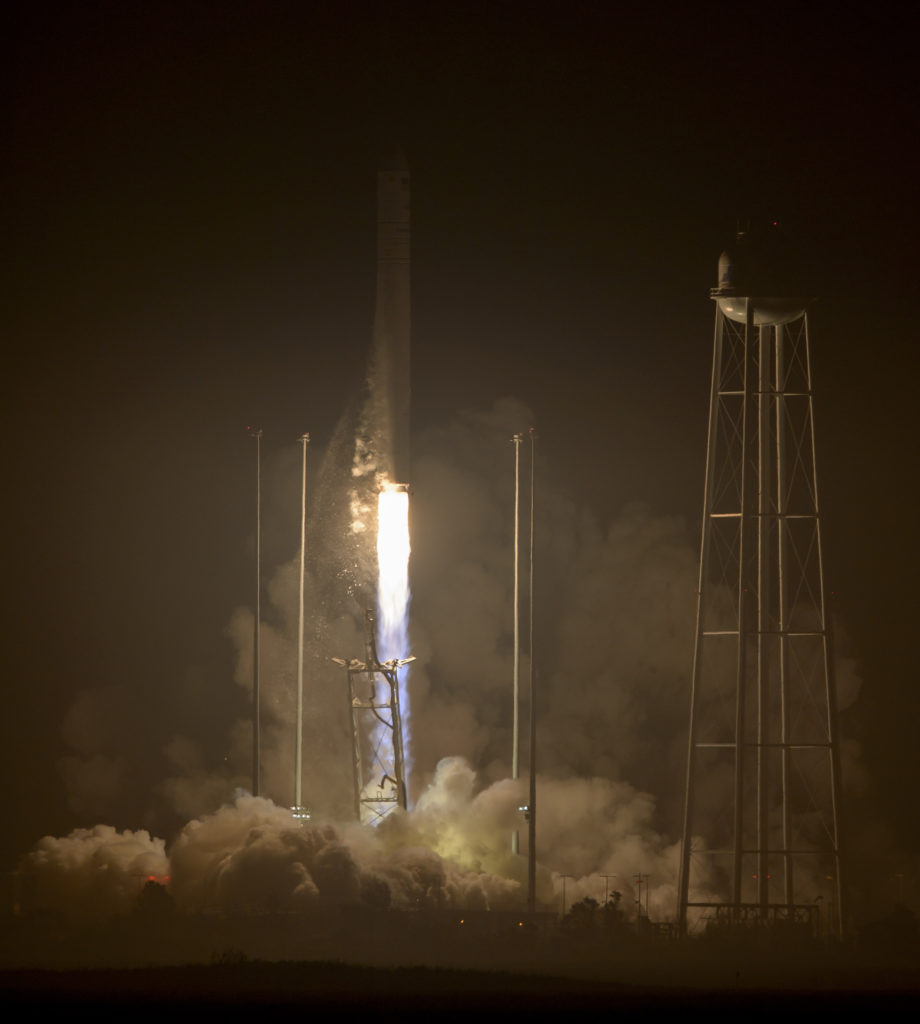
Liftoff of Orbital ATK’s Antares rocket and Cygnus cargo spacecraft occurred at 7:45 p.m. EDT this evening, Oct. 17, 2016, from the Mid-Atlantic Regional Spaceport Pad 0A at NASA’s Wallops Flight Facility on Virginia’s Eastern Shore.
An hour and a half after launch, commands will be given to deploy the spacecraft’s UltraFlex solar arrays.
Launch coverage will continue on NASA TV at https://www.nasa.gov/nasatv until shortly after spacecraft separation then resume at about 9:05 p.m. for solar array deployment, which is expected to last about 30 minutes.
A post-launch news conference will follow and is scheduled to begin on NASA TV at approximately 10:00 p.m.
Upcoming Milestones (Approximate Times)
- 7:49 p.m. Main Engine Cutoff on Antares first stage
- 7:49 p.m. Stage 1 Separation
- 7:49 p.m. Fairing Separation
- 7:49 p.m. Interstage Separation
- 7:49 p.m. Second stage ignition
- 7:53 p.m. Stage 2 Burnout/orbit insertion
- 7:54 p.m. Cygnus Separation from second stage
- 9:10 p.m. NASA TV Commentary resumes for Solar Array Deploy
- 9:15 p.m. Solar Array Deployment Begins
- 9:45 p.m. Solar Array Deployment Ends
- 9:50 p.m. Commentary ends
- 10:00 p.m. Post-launch news conference
Cygnus is scheduled for arrival at the International Space Station on Oct. 23, with about 5,100 pounds of supplies and payloads, including critical materials to directly support dozens of the more than 250 science and research investigations that will occur during the space station’s Expeditions 49 and 50.

Winslow Township, NJ….no sighting.
Saw it in Montross! Awesome!
We saw it from penhook va over smith mountain dam area. Very cool
No sighting from Orwigsburg, Schuylkill County, PA.
launch was a beautiful sight in the SSW sky that arched up and east here in lower sussex county, DE
Could see it as a tiny, faint red dot from Northampton, PA. They’re usually brighter here but some thin, hazy clouds on the horizon dimmed this one.
Saw it in Alexandria Va right before it flamed out – at least that is what it looked like.
West Chester, PA – Lower in the horizon. Bright red, fast-moving dot. Could see it for about 90 seconds.
No Sighting from Lake Marion S.C.
Definitely dimmer than last time, but saw it from Mechanicsburg, PA. Looked yellowish orange
Awesome! ! Saw in Easton PA!!
Saw the red flair of the separation In laurel md …Nancy
Clear skies and an amazing sighting for us in Suffolk, VA!
Saw in Alexandria, VA!
Saw it in Alexandria Va
Could see it for about a minute before it dropped below tree line. At approx 25-30 degrees above south east direction moving toward south south east. Bright white light moving fast in Greenville NC.
Fuquay-Varina, NC. Saw 1st stage burn, spark at separation, then dark coasting. Surprised to see most of 2nd stage burn too!
Saw in in Elk County, Pa. Tiny orange dot just above tree line. It appeared…disappeared…reappeared…disappeared in seconds. Very tiny and quick.
Saw it from Hubert NC
Very good sighting from top of Newark Delaware reservoir. Small but very clear until faring separation. Thanks for NASA tv and the app. Crowd listened to launch from my phone.
Saw on Gaithersburg, MD
Saw it over the ocean in Bethany Beach, DE, or over 1 minute, until separation. We could even make out the shape of the flame. Really awesome
Saw it from Pine Beach NJ. Tiny red flair in the SSW sky traveling east about 7:50. Quite a site.
Saw it from Atlantic, VA. Awesome
Saw it in Fredericksburg, Va. Neato!
Saw it with kids in South Riding, VA. Awesome ! Congratulations to the team !!
Saw it for about 3 mins in Millersville, Md. very exciting !!
Saw it from Gibson Island Pasadena, MD
Saw it from the beach in front of the Tropicana in Atlantic City, NJ! Very cool.
We saw it from DC! Cool experience!
I thought somebody from your are put it on YouTibe
Saw it in Woodbridge VA.
Could not see it in Wernersville, Berks County, Pennsylvania although we went up the hill to view. Skies were clear and no obstruction; even had our high power telescope.
It was awesome. Saw it on YouTube.
Still using Russian engines….
Perfect View from Wallops NASA Center….Great gaggle of folks. Parking impossible.
I am not a jinx…It didn’t explode this time!